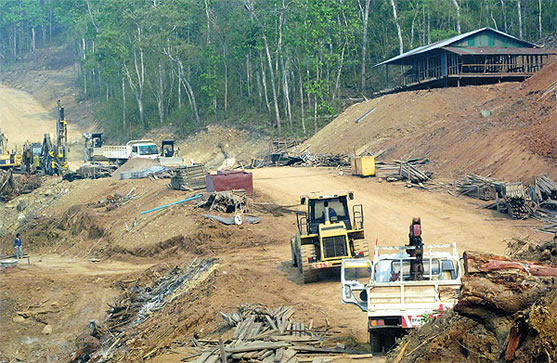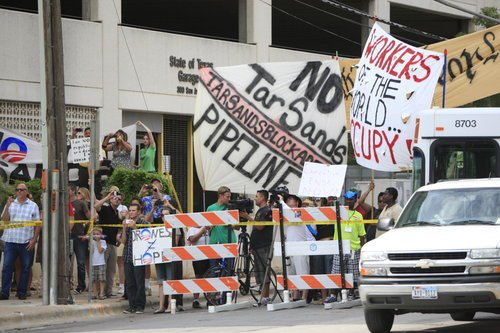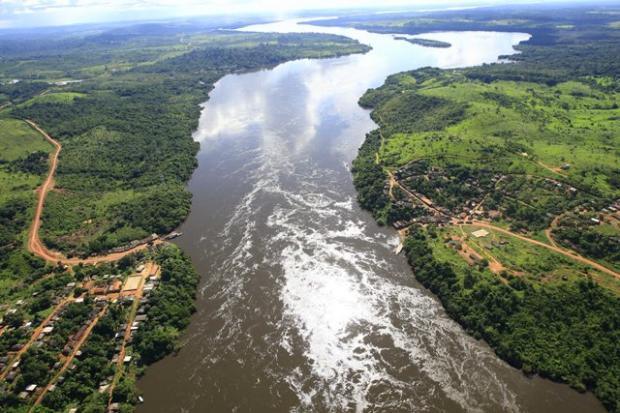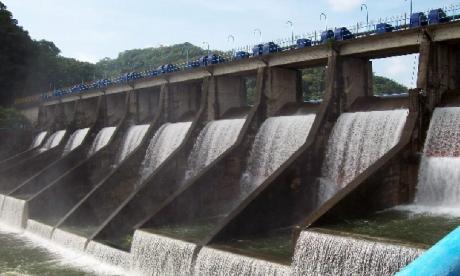
by Deep Green Resistance News Service | Aug 20, 2012 | Biodiversity & Habitat Destruction
By Lawrence Del Gigante / Inter-Press Service
“While each project proposed in Cambodia comes with a different set of impacts, large dams are likely to widen the gap between the rich and the poor, increase malnourishment levels and lead to an environmentally unsustainable future,” Ame Trandem, South East Asia programme director for International Rivers, told IPS.
Four dam projects have been approved so far in Cambodia, with one already operational. All are being developed by Chinese companies on build-operate-transfer agreements, according to Trandem.
The Mekong River runs through six countries, including China and Vietnam, most of which are planning the construction of hydroelectric dams.
“The plans to build a cascade of 11 Mekong mainstream dams is one of the greatest threats currently facing Cambodia,” said Trandem.
The mandate on planning and development of hydropower in Cambodia lies within the ministry of industry, mines and energy, which did not respond to requests for comment.
Another danger of damming the Mekong is the threat to the Mekong delta, an extremely fertile area of land which is responsible for much of the region’s rice supply.
“As the Mekong River feeds and employs millions of people in the region for free, it would be irresponsible to proceed with the Xayaburi and other mainstream dams,” said Trandem.
The Mekong is one of the only rivers in the world to reverse its flow in the dry season. This natural mechanism buffers the intrusion of salt water from the South China Sea into the delta, and could be upset by upstream development.
Dams also block fish migration routes, alter flows, and change aquatic habitats, so these projects are also likely to have an adverse effect on Cambodia’s fisheries.
“The Mekong River Commission’s Strategic Environmental Assessment warned that more than one million fisheries-dependent people in Cambodia would lose their livelihoods and even more would suffer from food insecurity,” said Trandem.
“The loss of even a small percentage of the Mekong’s fisheries can represent in a loss of tens of millions of dollars.”
Partnerships have been established between the countries through which the Mekong runs in order to prevent overharvesting of the river’s resources. However, China is not a signatory to the 1995 Mekong Agreement, and can effectively build these projects independently from downstream countries. The dams in Cambodia are being financed by Chinese investors.
“The impacts of these projects are already being felt downstream,” said Trandem.
Hydroelectricity, even if a successful venture, will not solve the country’s electrification problems, other analysts say.
“Right now it is relatively catastrophic, the power situation in the country,” Alexander Ochs, the director of climate and energy at the Washington-based Worldwatch Institute, told IPS.
Cambodia has one of the lowest electrification rates in Southeast Asia, estimated at only 24 percent, according to the Asian Development Bank (ADB).
The government aims to raise the national electrification rate to 70 percent by 2020, according to the ADB, by expanding the grid and sourcing more than half of the needed electricity from the Mekong River.
A large complication is transmitting the electricity, with only the major cities and surrounding areas having access to power lines, meaning people in rural areas will not benefit from the hydro.
“The number of people that are really connected to a grid as we know it, a modern power service or energy line, in rural areas is as little as seven percent of the population. Overall, nationwide, it’s about 15 percent,” said Ochs.
Read more from Inter-Press Service: http://www.ipsnews.net/2012/08/cambodias-hydro-plans-carry-steep-costs/

by Deep Green Resistance News Service | Aug 15, 2012 | Climate Change, Obstruction & Occupation
By Will Wooten / Waging Nonviolence
One year after more than 1,200 people were arrested in front of the White House during two weeks of sit-ins against the Keystone XL tar sands oil pipeline, a coalition of Texas landowners and activists will attempt to physically halt its construction. Led by veteran climate justice organizers, participants ranging from environmentalists to Tea Partiers are preparing to lock arms for a sustained nonviolent civil disobedience campaign, beginning perhaps as early as this week.
The impetus for such action, which is being called the Tar Sands Blockade, goes back much further than last summer, however. In 2008 and 2009, small landowners along the pipeline’s route in rural Texas, Oklahoma and Nebraska started noticing survey stakes with orange tape marked “KXL.” They soon found out that TransCanada — the company building the pipeline — had eminent domain power over their property and that if they didn’t sign a contract allowing TransCanada to build, they would be taken to court.
Many landowners, feeling pushed into an impossible situation, signed the contracts. Some began organizing, doing community outreach to explain what was happening and building conservative support on the ground. Organizations such as Nacogdoches Stop Tarsands Oil Pipelines evolved out of conversations between landowners — first focusing around eminent domain, but then, when they learned that tar sands oil would be pumped through the pipeline, discussion started to include environmental impacts, such as toxic diluted bitumen and climate change.
By August 2011, the climate movement in the United States started to focus in on the Keystone XL with Tar Sands Action, a civil disobedience campaign led by Bill McKibben and members of 350.org. The 1,253 arrests in front of the White House helped raise the issue to a national level by stressing that President Obama could stop the pipeline by rejecting its permit to cross the U.S.–Canada border.
Weeks later, the Occupy movement emerged. While environmental issues were not at the forefront, many Occupy encampments passed resolutions opposing Keystone XL and took part in Tar Sands Action’s next rally in Washington, D.C., when, on November 6, 12,000 people encircled the White House. Days later President Obama denied the permit and, for the moment, Keystone XL was thought dead.
TransCanada then changed tactics and decided to split the pipeline into segments so that it could get a head start on construction while making inside deals in Washington to secure the necessary permit for crossing the border. In a sign of goodwill to the fossil fuel industry, President Obama went to Cushing, Oklahoma, and declared that he would “expedite” the permitting process for the Gulf Coast segment from Cushing to Houston and Port Arthur, Texas. While that ability was technically outside of his reach, it was a hint to the agencies responsible for such decisions. Perhaps not surprisingly, the Army Corps of Engineers then granted the three permits TransCanada needed to start construction — despite the absence of an environmental review.
The southern segment of the Keystone XL will be built in three different sections, simultaneously, with the goal of transporting tar sands oil currently stored in Cushing, Oklahoma, to refineries on the Gulf Coast, where it then can be shipped around the world. When Texas activists such as myself learned that this was happening despite the Tar Sands Action victory, we decided to form Tar Sands Blockade.
While landowners began organizing along the pipeline route in early 2012, climate justice activists with Rising Tide North Texas were looking for ways to bring wider attention to the pipeline’s impending construction. Many of us had been active Occupiers during the encampments and were disappointed with the movement’s inability to make the connection between economic justice and the climate. So we made a stronger effort to engage people on the community level.
As a result, Tar Sands Blockade is being informed by a variety of voices — from self-identified Tea Party members, flying Gadsden flags at the front of their long driveways, to Occupiers who slept at encampments across the country.
Several organizers with Tar Sands Blockade also participated in and organized for Tar Sands Action, including veteran climate justice activists from around the country. This diverse coalition has agreed on one simple call to action: The Keystone XL should not be built in Texas, and nonviolent direct action is required to stop it.
Other means of addressing the grievances of landowners and meeting the challenge of climate change have thus far failed. As Bill McKibben’s recent article “Global Warming’s Terrible New Math” made clear, the world has years, not decades, to confront the fossil fuel industry head on. Nonviolent direct action offers the best chance of victory, not just for the Tar Sands Blockade but for other fossil fuel extraction movements, such as those opposing fracking, mountaintop removal and coal exports — all of which have been active in what’s being called a Climate Summer of Solidarity.
That solidarity will take on greater meaning in a matter of days when construction on the pipeline is expected to begin and landowners will be bringing ice to the encampments to help alleviate the extreme Texas heat, as well as thanking everyone for defending the home they’ve built over decades. Activists will respond by holding the blockade for as long as possible, through the summer and likely into the fall. This could be an important moment for the entire climate movement, setting the stage for future actions and alliances — not to mention giving new meaning to the words “Don’t mess with Texas.”
From Waging Nonviolence: http://wagingnonviolence.org/2012/08/dont-mess-with-texas-tar-sands-blockade/

by Deep Green Resistance News Service | Aug 14, 2012 | Indigenous Autonomy, Lobbying
By Zachary Hurwitz / International Rivers
Federal Judge Souza Prudente of the Federal Tribunal of Brazil’s Amazon region suspended all work today on the Belo Monte Dam, invalidating the project’s environmental and installation licenses.
While the project has been suspended previously on numerous occasions, and those suspensions overturned on political grounds, this latest decision could have some legs. The decision breaks down in the following way:
- The federal judge ruled that no consultations were held with indigenous people prior to Congress issuing Decree 788 in 2005, which effectively approved the Belo Monte Dam. Article 231 of the Brazilian Constitution requires consultations to be held directly by the Congress prior to approval. In this case, approval was given three years before publication of the environmental impact assessment, after which consultations began.
- As a result, the project’s environmental license (granted in 2010) and installation license (granted in 2011) are now considered invalid, meaning that no further work can continue on the dam.
- Brazil’s National Congress must hold a series of public hearings, or consultations, with the indigenous tribes that will be affected by Belo Monte. Only after such consultations occur and are considered satisfactory, must the Congress legislate a new approval for the dam.
- The government and project consortium Norte Energia, S.A. can appeal to Brazil’s Supreme Court, Brazil’s Superior Court of Justice, the President of the Federal Tribunal, and Brazil’s Attorney General, in the next 30 days. Since this is a constitutional matter, the appeal is likely to go to the Supreme Court.
In a press conference given today late in Brasil, Souza Prudente stated that “only in a dictatorial regime does a government approve a project before holding consultations.”
The decision supports the arguments that the affected tribes have been making over the lifetime of Belo Monte: tribes will face downstream livelihood impacts as a result of a reduction in the flow of the Xingu River on the 100-km stretch known as the Volta Grande or “Big Bend,” and were never properly consulted, much less gave their consent.
In the words of the decision itself,
“installation will cause direct interference in the minimal ecological existence of the indigenous communities, with negative and irreversible impacts on their health, quality of life, and cultural patrimony, on the lands that they have traditionally occupied for time immemorial. This requires the authorization of the National Congress after holding prior consultations with these communities, as deemed by law, under the penalty of suspension of the authorization, which has been granted illegally.”
Beyond the fact that the Belo Monte Dam is now considered illegal by one of Brazil’s higher courts, the fact is that Brazil doesn’t need Belo Monte. Economic rationale for the dam is based on a projected economic growth of 5% or more a year, but over the past few quarters, GDP has been lucky to grow at even a measily rate. As far as Belo Monte’s importance to Brazil’s economic race, this is really a case of the horse following the wagon.
And, as illustrated by this historic court decision, the wagon has been trampling on indigenous people and their rights, along the way.
From International Rivers: http://www.internationalrivers.org/blogs/258/belo-monte-dam-suspended-by-high-brazilian-court
by Deep Green Resistance News Service | Aug 7, 2012 | Mining & Drilling, Toxification
By Steve Mufson / The Washington Post
Jane Kleeb is a savvy activist who, Nebraska’s Republican governor once said, “has a tendency to shoot her mouth off most days.” A Florida native who moved to Nebraska in 2007 after marrying a rancher active in Democratic politics, she did as much as anyone to bring the massive Keystone XL crude oil pipeline to a halt last year.
James Goecke is a counterpoint to Kleeb. A hydrogeologist and professor emeritus at the University of Nebraska in Lincoln, he has been measuring water tables in Nebraska’s ecologically sensitive Sand Hills region since 1970 and has shunned the political limelight — until now. He recently appeared in an ad for the pipeline’s owner, TransCanada, rebutting some of the arguments against the project and its new route.
Under ordinary circumstances, Kleeb and Goecke would be natural allies. Democrats in a red state, they both care about preserving Nebraska’s unique environment. Instead, they are divided over Keystone XL, a 1,700-mile steel pipeline that would carry heavy, low-quality crude from Canada’s oil sands to refineries in Texas.
At the heart of their battle is whether the pipeline would pose a threat to the massive Ogallala Aquifer — one of the world’s largest underground sources of fresh water. By one calculation, it holds enough water to cover the country’s 48 contiguous states two feet deep. The Ogallala stretches beneath most of Nebraska from the Sand Hills in the west to the outskirts of Omaha. And it runs from South Dakota well past Lubbock, Tex.
Named after a Northern Plains tribe, the Ogallala provides water to farms in eight states, accounting for a quarter of the nation’s cropland, as well as municipal drinking wells. Though early white explorers who saw this apparently arid part of the Great Plains called it a “great American desert,” the aquifer has turned it into America’s breadbasket.
The spongelike aquifer formed more than 20 million years ago, when erosions of gravel and sand from the Rocky Mountains were washed downstream. It is replenished by rain and melting snow, but it gets just two to five inches of precipitation a year, according to a TransCanada filing to the Nebraska Department of Environmental Quality. Much of the water it holds was absorbed thousands or millions of years ago.
In some places the aquifer is buried 1,200 feet deep, but in many places it is at or very close to the surface, often less than five feet below ground. In these places, you can literally stick a stake in the ground and hit water. Extensive stretches of Nebraska’s plains require no irrigation; to keep cattle watered, ranchers just dig a hole and the water flows in.
That’s where concerns about the Keystone XL came in. Its original route traversed 92 miles of the Sand Hills and the Ogallala. TransCanada, which said it would bury the pipeline at least four feet underground, could in many places be putting it in water.
If the pipeline should spring a leak where it touches the aquifer or even above it, Kleeb and other opponents say, oil could quickly seep into and through the porous, sandy soil. The Ogallala, Kleeb said last year in a television interview, is “a very fragile ecosystem, literally made of sand. . . . To have a pipeline crossing that region is just mind-boggling.”
She cited University of Nebraska civil engineering professor John Stansbury, who drew on pipelines’ history and TransCanada regulatory filings to predict that during the projected 50-year life span of the pipeline, “there would be 91 leaks . . . that could potentially put 6.5 million gallons of tar sands oil in the Ogallala aquifer and essentially contaminate our drinking water.”
He maintained that a worst-case spill in the Sand Hills region could pollute 4.9 billion gallons of groundwater with a “plume” of contaminants 40 feet thick, 500 feet wide and 15 miles long.
The message rallied Nebraskans from ranches to cities, and it was what President Obama pointed to in January when he rejected the initial Keystone XL route. In May, TransCanada submitted a revised route to the State Department, bypassing the Sand Hills but still passing over some parts of the aquifer.
“The Ogallala aquifer is the greatest underground water source, I believe, in the world,” said Gerald E. Happ, whose ranch in Greeley the pipeline originally would have crossed. “And it’s the purest. . . . And we need the water, and maybe the water may be way more precious than the oil sometime in the future.”
Read more from The Washington Post: http://www.washingtonpost.com/national/health-science/keystone-xl-pipeline-may-threaten-aquifer-that-irrigates-much-of-the-central-us/2012/08/06/7bf0215c-d4db-11e1-a9e3-c5249ea531ca_story.html

by Deep Green Resistance News Service | Aug 3, 2012 | Biodiversity & Habitat Destruction, The Solution: Resistance
By Emilio Godoy / Inter-Press Service
Small-scale hydroelectric dams with a capacity of under 30 MW are seen by the authorities in Mexico as an important alternative for generating energy. But local communities reject them on the argument that they would cause social, economic and environmental damages.
On the front line of the struggle are communities in the southern states of Puebla, Tabasco, Veracruz, Oaxaca and Chiapas, where there is great potential to harness hydro energy with small dams.
“They claim the so-called mini-hydroelectric plants don’t have a negative impact on communities, but people already have the necessary information to know that any kind of dam has an impact,” activist Angélica Castro, coordinator of public advocacy and citizen participation in Services for Alternative Education (EDUCA), told IPS.
EDUCA, a non-governmental organisation in Oaxaca, has been working since 2006 with the people of 39 communities in six municipalities in that state that would be affected by a 510 MW dam that the state Federal Electricity Commission (CFE) plans to build on the Verde River.
The communities, which have joined together in the Council of People United for the Defence of Río Verde (COPUDEVER), are opposed to the construction of the hydroelectric plant, whose environmental and socioeconomic impact studies have not yet been completed.
There are at least 50 public and private small-scale hydropower dams operating in Mexico, most of which are obsolete. Together, they generate around 50 MW of energy.
The National Commission for Energy Savings (CONAE) estimates that the southern states have the potential to produce over 400 MW of energy by mini-dams, at 72 identified locations.
Although Mexico’s southern states are the country’s poorest, they are rich in water, because of the large number of rivers and the high levels of rainfall. The non-governmental Mario Molina Centre reports that in Oaxaca and Chiapas, nearly all of the locally consumed electricity is generated by renewable sources like wind, geothermal and solar power, as well as miniature dams.
Mariana González, a transparency and accountability researcher with the FUNDAR Centre for Analysis and Research, an interdisciplinary organisation that monitors public policies and institutions, told IPS that mini-dams “are profitable in the short-term, but they modify the soil and their surroundings without benefiting local communities.”
Between 2010 and 2012, FUNDAR advised four communities in Oaxaca that would have been affected by the Cerro de Oro small-scale dam, which was to generate 10.8 MW of electricity. The villages managed to block the project.
The companies building the dam had not consulted the local communities before the start of construction, in 2010.
Read more from Inter-Press Service: http://www.ipsnews.net/2012/08/mexican-communities-fight-mini-dams/




